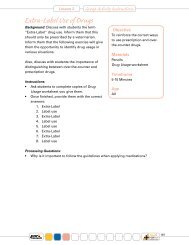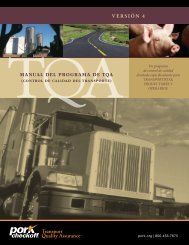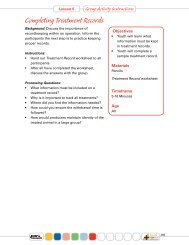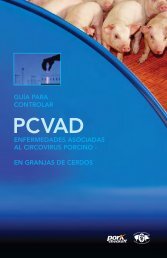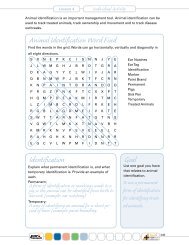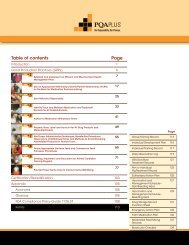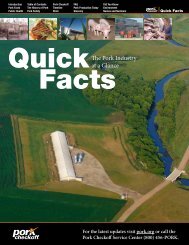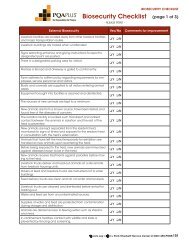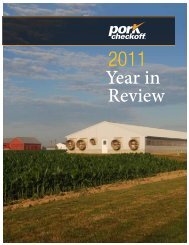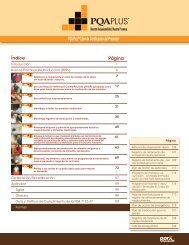PRRS Compendium Producer Edition - National Pork Board
PRRS Compendium Producer Edition - National Pork Board
PRRS Compendium Producer Edition - National Pork Board
You also want an ePaper? Increase the reach of your titles
YUMPU automatically turns print PDFs into web optimized ePapers that Google loves.
Introduction<br />
A tentative diagnosis of <strong>PRRS</strong> virus infection is suggested by clinical signs; reproductive problems in<br />
breeding stock or respiratory disease in pigs of any age. Reproductive problems associated with <strong>PRRS</strong> include<br />
poor conception rates, late-term abortions, and an increase in the rate of stillborn pigs, mummified<br />
fetuses, and weak, non-viable piglets. Infection with <strong>PRRS</strong> virus often does not induce unique gross or microscopic<br />
lesions, although interstitial pneumonia is a common finding in the respiratory form. In addition,<br />
the gross lesions caused by <strong>PRRS</strong> virus infection may resemble or be obscured by lesions caused by other<br />
infectious agents.<br />
Due to the similarity of clinical signs of <strong>PRRS</strong> virus infection to those caused by other viral and bacterial<br />
pathogens and the lack of <strong>PRRS</strong> virus-specific lesions, differential tests are required for a definitive diagnosis.<br />
The differential diagnosis includes infection with porcine parvovirus, pseudorabies virus, hemagglutinating<br />
encephalomyelitis virus, porcine circovirus type 2, porcine enterovirus, swine influenza virus,<br />
classical swine fever (hog cholera) virus, porcine cytomegalovirus, and leptospirosis (Allan and Ellis, 2000;<br />
Keffaber, 1989; Halbur et al., 1993, 1995a; Mengeling et al., 1993; Paton et al., 1992b; Yoon et al., 1996a).<br />
Therefore, when the clinical history and pathology is suggestive of <strong>PRRS</strong>, detection of viral antigens, viral<br />
genomic material, or isolation of virus from clinical specimens must be used to confirm the tentative diagnosis.<br />
Alternatively, documentation of rising serum antibodies in a time frame compatible with the clinical<br />
episode may support the diagnosis. This chapter describes laboratory procedures for the diagnosis of<br />
<strong>PRRS</strong> virus and approaches for diagnostic investigation to confirm <strong>PRRS</strong> virus infection in a herd.<br />
General Guidelines for <strong>PRRS</strong> Diagnosis<br />
Diagnosis is based on obtaining evidence of <strong>PRRS</strong> virus infection in animals suspected of harboring the<br />
infection. Such evidence may be obtained by isolating <strong>PRRS</strong> virus or detecting <strong>PRRS</strong> viral antigens or<br />
nucleic acid in the animals. In clinically affected animals, demonstration of suggestive pathological lesions<br />
supports the diagnosis of <strong>PRRS</strong> in conjunction with laboratory testing. It should be kept in mind that <strong>PRRS</strong><br />
virus or <strong>PRRS</strong> viral RNA can be detected in clinically normal animals vaccinated for <strong>PRRS</strong> or animals persistently<br />
infected. Timing after vaccination or history of previous exposure should be taken into consideration<br />
when conducting a diagnostic investigation for <strong>PRRS</strong>.<br />
Successful isolation and/or detection of viruses in clinical materials are highly dependent on proper collection<br />
and handling of specimens. In general, specimens intended for virus assays should be collected as<br />
early as possible in the course of the disease, i.e., within the first 7-10 days after the onset of illness. Samples<br />
collected during the acute phase of viral infection usually contain adequate amounts of virus for detection<br />
in available assays. Samples collected later in the course of infection usually require more laboratory<br />
time and often yield poor or negative results. It is important to choose not only the most appropriate<br />
specimen, but also to collect an adequate amount of specimen for virological testing. Insufficient amounts<br />
of sample are a potential cause of inconclusive diagnosis or false-negative result.<br />
For best results in isolation and detection of viruses, clinical specimens should be aseptically collected,<br />
kept fresh, and transported immediately to the laboratory. If delays are unavoidable or any detrimental<br />
affects on virus in samples are anticipated during transport, samples should be refrigerated at 40°F (4°C)<br />
for no more than 2 days. For longer storage periods, freeze samples at –70°C, but NEVER at –20°C. Selfdefrosting<br />
freezers in conventional refrigerators are not appropriate for storage. Ideally, frozen samples<br />
should be submitted on dry ice, but commercial refrigerant packs can be used if necessary.<br />
Demonstration of seroconversion or increasing titers of <strong>PRRS</strong> virus-specific antibody in a group of affected<br />
animals can also be used for diagnosis of <strong>PRRS</strong> virus infection. One must exercise caution when interpreting<br />
serology in herds already known to be infected or vaccinated. This is due to the fact that none of<br />
the available serologic tests can differentiate positive results due to infection from positive results due to<br />
vaccination. Additionally, serology can not be relied upon to determine how long a pig has been infected.<br />
Serologic testing coupled with an epidemiological approach, such as case-control or longitudinal studies,<br />
strengthens the use of serology for <strong>PRRS</strong> diagnosis. When herd monitoring is desired, utilizing other tests<br />
such as polymerase chain reaction (PCR) or virus isolation (VI) in combination with serology will give the<br />
producer and veterinarian a clearer picture of virus transmission patterns.<br />
PAGE<br />
PIG 04-01-09





